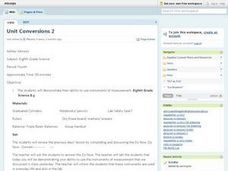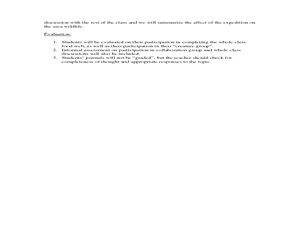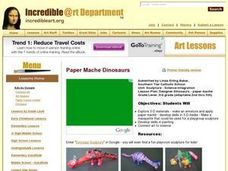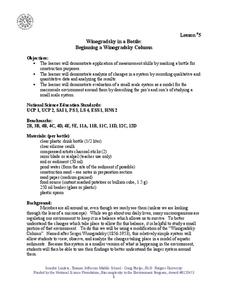Curated OER
Changing Places
This lesson involves live ladybugs. Students view two containers of water and take the temperature of each. They construct a graph on chart paper to compare the two containers. Students speculate which water sample the ladybugs will like...
Curated OER
Matter Unit
Students create products from studying about matter that include: Make a "T" chart with matter and non matter items. Write a poem, song, or rap about matter. Five vocabulary words from the chapter must be included in the poem.
Curated OER
Water and Ice
Learners conduct an experiment. In this forms of water lesson, students observe ice to see what changes take place and then write in their journal about what they observed.
Curated OER
Life Cycle Of Stars
Young scholars investigate the concept of stars and how they go through a life cycle. They take part in class discussion with the help of dialogue provided in the lesson plan. Students also view a powerpoint presentation for visual...
Curated OER
Unit Conversions 2
Eighth graders demonstrate the use of instruments of measurement. As a class, they take notes and observe the proper procedure for using a graduated cylinder, a ruler, and a balance/triple beam balance. In groups, 8th graders visit...
Curated OER
A Guide (on the Side) to Physics
Students engage in a lesson plan that is concerned with the concepts related to the study of Physics. They participate in class discussion and list common misconceptions of Physics. Students write and discuss the problem of Science...
Curated OER
Get to Know Snow!
Students learn about snow. In this snow themed lesson, students read a book, make a painting, and observe snow. A math activity timing how long it takes for snow to melt is included.
Curated OER
Moonwalking to Mars?
Students examine a quote from George W. Bush's recent speech on space exploration. They evaluate one writer's stance on Bush's space exploration goals by reading and discussing "Plea to Policy Makers: Let's Take Another Giant Step." In...
Curated OER
Desert Tortoise Adaptations
Students observe the Desert Tortoise in its natural surroundings. In this adaptations lesson, students study and take pictures of an animal in its habitat, then design a PowerPoint which addresses adaptations, biodiversity, and threats...
Curated OER
Winogradsky in a Bottle: Beginning a Winogradsky Column
Students use their measurement skills by marking a bottle for construction purposes. They record qualitative and quantitative data and analyze their results. Students demonstrate evaluation of a small scale systems as a model for the...
Curated OER
Don't Worm Your Way Out of This One!
Students study different aspects of worms along with the process of vermicomposting by participating in a class experiment to study the time it takes for breakfast cereal to be eaten by worms.
Curated OER
Momentum and Energy
Students study how to calculate momentum, kinetic, and potential energy. They apply each form of energy to real world situations including demonstrations, watching videos, and designing a Power Point presentation. They investigate in...
Curated OER
Weight Lifter - An Air Pressure Experiment
First graders participate in a study of air pressure in which the investigate if air has the strength to lift heavy objects. They work in teams to develop a hypothesis about whether air in bags would be able to lift a stack of books....
Curated OER
Animals and the Food Webs that Love Them
Students study the animals that Lewis and Clark would have encountered. In this animals lesson students study the food web and how human populations have affected them.
Curated OER
Sputnik
Students study Sputnik and what it looks like. In this Sputnik instructional activity students complete several activities while in groups.
Curated OER
Our Amazing Skeleton
Students study the skeleton, about the number of and types of bones in the body, and how outer space affects astronauts' bones. They discover how to take care of their bones here on Earth to prevent osteoporosis, or, weakening of the...
Curated OER
Puerto Rican Parrot Paradise
Students investigate the environment of the Puerto Rican Parrot. They visualize the ecosystem with and without information. They conduct research to find information and participate in classroom discussion to demonstrate comprehension of...
Curated OER
"Write" Answers
Students examine the Q.& A. articles found each week in Science Times, focusing on how the answers are presented in a clear and logical way, as well as the relevance of understanding science's roles in our daily lives.
Curated OER
Designer Dinosaurs - Paper Maché
Third graders explore 3-D materials by making a macquette that could be used for a playgroup sculpture. The students design and execute papier-mâché dinosaurs. They develop painting skills and connect art to science.
Curated OER
Evolution and Antibiotic Resistance
Students investigate the increasing problem of antibiotic resistance in such menacing diseases as tuberculosis and influenza. They take on the role of staff at a public health agency who are trying to communicate the problem to the public.
Curated OER
A River Ran Through It
Students research how water is used to generate electricity. They investigate water's potential-to-kinetic energy transfer in hands-on activities about falling water and waterwheels. They take measurements, calculate averages and graph...
Curated OER
What's down there?
young scholars analyze how oil is formed and where in the Earth we find it. Students take a core sample to look for oil in a model of the Earth. They analyze their sample and make an informed decision as to whether or not they should...
Curated OER
Which Animals Should Be Saved?
Fifth graders investigate the concepts related to the endangerment of different animal species. They conduct research using a variety of resources. The skills of prediction are used to show the possible outcome of the extinction of a...
Curated OER
Winogradsky in a Bottle: Beginning a Winogradsky Column
Students study changes in the environment using a microscale experiment. In this environmental science lesson, students construct a modified "Winogradsky Column" to observe bacteria activities. They record observations and formulate a...























